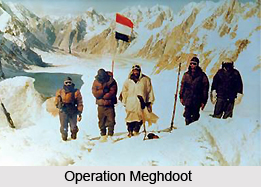 Operation Meghdoot was the code name for the operation of Indian Army to capture the Siachen Glacier in the Kashmir region, for settling the Siachen Conflict. This military operation, launched on 13th April 1984, was unique because of its first attack, which was launched in the world`s highest battlefield. The military action resulted in Indian army gaining control of the entire Siachen Glacier. The name Meghdoot has been derived from the 4th century AD Sanskrit play by Kalidasa, Meghaduta, which means cloud messenger.
Operation Meghdoot was the code name for the operation of Indian Army to capture the Siachen Glacier in the Kashmir region, for settling the Siachen Conflict. This military operation, launched on 13th April 1984, was unique because of its first attack, which was launched in the world`s highest battlefield. The military action resulted in Indian army gaining control of the entire Siachen Glacier. The name Meghdoot has been derived from the 4th century AD Sanskrit play by Kalidasa, Meghaduta, which means cloud messenger.
Reason for Planning Operation Meghdoot
The Siachen Glacier became a bone of debate following a ambiguous demarcation of territories in the Karachi Agreement of July 1949 which did not exactly specify who had authority over the Siachen Glacier area. Indian interpretation was that Pakistan territory extended only to about the Saltoro Ridge based on the Simla agreement where the territorial line`s route after the last demarcated Point NJ 9842 was from north to the glaciers. Pakistan interpretation was that their territory continued in northeast from Point NJ 9842 to the Karakoram Pass. As a result of which, both of the nations claimed the barren heights and the Siachen Glacier.
In the 1970s and early 1980s, Pakistan permitted several mountaineering expeditions to climb the peaks in the Siachen region from their country side. In 1978, the Indian Armed Force also allowed mountaineering expeditions to the glacier, approaching from their side. The most notable expedition was by Colonel Narinder "Bull" Kumar of the Indian Army, who led the expedition to Teram Kangri.
The conflict actually started when Pakistan gave permission to a Japanese expedition to ascend the Rimo I peak in 1984. This permission further flamed the suspicion of the Indian Government of Pakistani attempts to legitimize their claim. The peak, located on the east of the Siachen Glacier, also overlooks the northwestern areas of the Aksai Chin which is occupied by China but claimed by India. The Indian military believed that such an expedition could advance a link for a trade route from the Chinese to the Pakistani sides of the Karakoram Range and eventually provide a strategic advantage to the Pakistani Army.
Execution of Operation Meghdoot
The Indian military decided to deploy soldiers from Northern Ladakh region as well as some paramilitary forces to the glacier area. Most of the soldiers had been accustomed to the extremities of the glacier through a training expedition to Antarctica in 1982 before eventually launching the operation to occupy the entire glacier.
In 1983, Pakistani generals also decided to stake their claim through soldier deployments to the Siachen glacier region. After analysing the Indian Army`s mountaineering expeditions, Pakistani army feared about the assumption of India capturing the key ridges and passes near the glacier. So, they decided to send their own soldiers before India and Islamabad ordered Arctic-weather gear from a London supplier. They were unaware that the same supplier provided equipments to Indian Army as well. So, Indian Army was easily informed about this development of Pakistani Army and so they quickly initiated their own plan.
As intelligence had reported that the Pakistani operation planned to occupy the glacier by 17th April, Indians planned the operation to conquer the glacier on 13th April 1984, 4 days before the Pakistani Armed Force. Operation Meghdoot was led by the Lieutenant General Prem Nath Hoon; the task of occupying the Saltoro ridge was given to 26 Sector, commanded by Brigadier Vijay Channa, who was tasked with launching the operation between April 10 and 30. He chose April 13, supposedly an unlucky date, because it was the Vaisakhi day, when the Pakistanis would be least expecting the Indians to launch an operation.
Consequence of Operation Meghdoot
There are excursive views on the strategic value of the operation. Some consider it as a futile capture of non-strategic land which antagonized the relations between India and Pakistan. Others consider the operation to be a daring success by the Indian Military and ensured that the Indian military held tactical high ground on the strategic Saltoro Ridge just west of the glacier, at a high cost.
Currently the Indian Army controls all of the 70 kilometers long Siachen Glacier and all of its tributary glaciers, as well as the three main passes of the Saltoro Ridge immediately west of the glacier, which are Sia La, Bilafond La, and Gyong La, thus holding onto the tactical advantage of high ground.
Casualties for Operation Meghdoot
There is no reliable data available for casualties of this operation. However, both sides incurred most of their casualties from the weather and the terrain. A large number of soldiers from both of the nations suffered frostbite and high altitude sickness or were lost in avalanches or crevasses during patrols. According to the Minister State for Defence Dr. Subhash Bhamre, from 1984 to 2016 almost 35 officers and 887 JCOs/Ors have lost their lives in Siachen Glacier.






